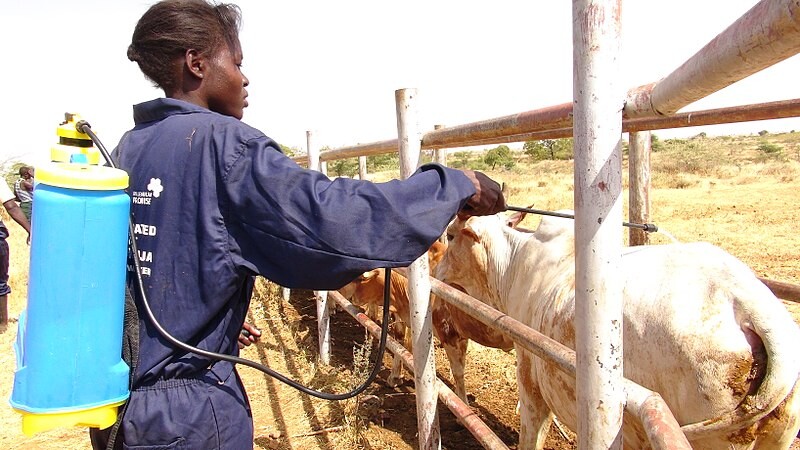

Regular spraying of livestock safeguards against pests such as ticks, tsetse-fly, biting flies, lice and fleas. In the long run the aim is to control the spread of diseases carried by these pests such as Nagana and Tick-borne diseases like East Coast Fever. It is always good practice to spray all domestic animals that are susceptible to infection. These include cattle, pigs, donkeys, dogs, sheep and goats. Do not spray calves below 2 – 3 months of age to enable them develop natural immunity to some tick-borne diseases.
Crush pens
The crush pen is a very important structure that should be in the farm because it allows safe handling of animals. Although small animals can simply be held when being sprayed, larger animals like cattle require a crush pen. Individual farmers can construct a basic crush using locally available materials such as wooden posts, rails and nails. Improved crush pen are more durable and can be constructed by reinforcing the floor and around the posts with concrete and using more durable posts such as cedar wood or metal.
Due to some reasons communal crush pens are at times the most appropriate and desirable for a given locality. Communities can organize themselves to construct communal crush pens. These pens should be sited on community land preferably located along cattle routes or watering points. Where land is owned by an individual, the owners should commit themselves to its use before the relevant authority in writing. Community crush pens should be close to an accessible source of fresh and clean water. Care should be taken to avoid contamination of the water source with chemicals. The sites should be far away from crops to prevent damage through trampling or grazing by livestock. Shade trees over the holding pens are desirable. An ideal crush pen should have a soak pit to avoid soil pollution.
Spray all livestock weekly in tsetse infested areas using the correct formulation and carefully follow the manufacturer’s instructions.
Deltamethrin: Deltamethrin is usually supplied as 5% solution; one millilitre of this solution is diluted in one litre of water to prepare the spray wash. About three litres of the spray wash solution is required to spray an adult cow weighing around 200kg.
Alphacypermethrin: This is a synthetic pyrethroid usually available in a 10% formulation. One millilitre of the insecticide is mixed with 20 litres of water. This formulation can be used for both spraying and dipping of animals.
Flumethrin: Flumethrin is a synthetic pyrethroid solution supplied as 10% solution. It is a ready to use soluble liquid formulation. It is applied to animals as pour-on and can be used on lactating cows, sheep, goats, horses and dogs to control mange, mites, lice, biting flies, ticks and tsetse fly. It is applied at a rate of one millilitre per 10kg body weight. For example, a cow weighing 200kg will require 20mls of the pour on.
Spray early in the morning before animals get thirsty to minimize ingestion of the insecticide. A useful rule to remember is, do not spray in the heat of the day, spray before 9.00 am when the sun is not hot.
Hold the nozzle of the spray pump at a distance of 30cm (1 ft) from the animal and then spray all the body parts from the hind legs. Ensure that the whole body is covered by the wash. Give special attention to the following areas: Around the base of the horns, Around the anus, Udder and teats, Around and between the hoofs, Around the eyes, Inside the ears and For male animals, around the scrotum
 Contact Jaguza Support
Contact Jaguza Support